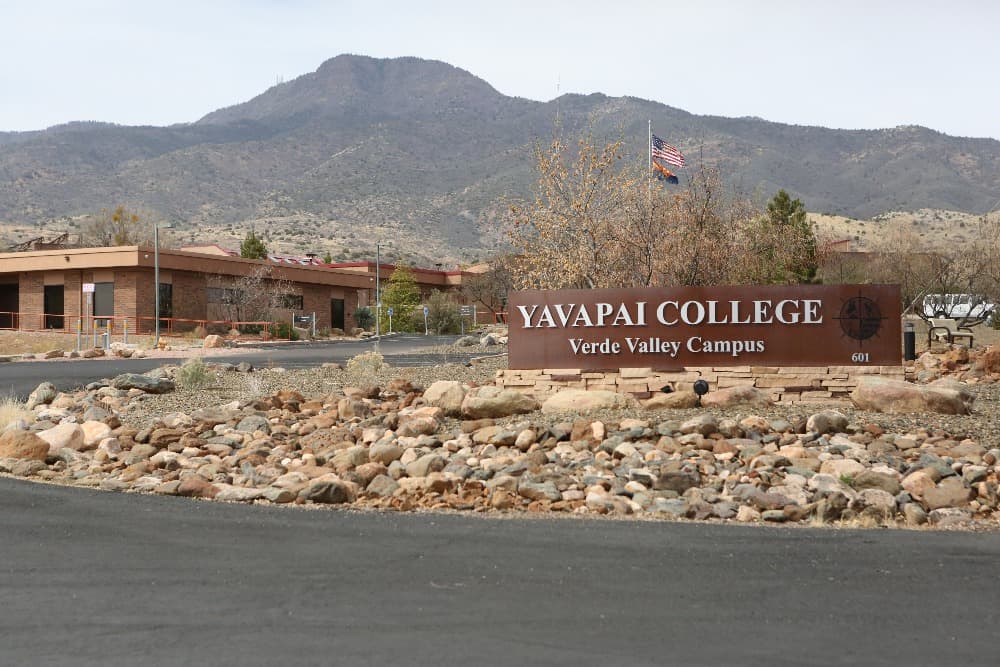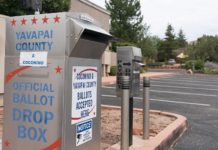The Yavapai College District Governing Board elections are less than a month away, and District 3 candidate Paul Chevalier is worried — not about cordially competing against District 3 incumbent Connie Harris, but about what he said is a stunt by Yavapai College administration to unfairly sway the election.
Chevalier said he recently became aware of newsletters that the college had intended to send out sometime this fall, potentially before election day on Tuesday, Nov. 6, which are subtitled “Face 2 Face,” and profile current board members and include their record serving their respective districts.
As challengers, Chevalier and District 1 hopeful Wayne Meddaugh, who is running against incumbent Chairman Ray Sigafoos in western Yavapai County, would not be profiled in any such taxpayer-funded newsletter. In a letter to Yavapai College President Penny Wills, Chevalier cited a state law regarding community colleges, Arizona Revised Statute §15-1408, which bars the use of community college district resources to influence elections.
“The timing is so suspicious. There’s no particular reason to put this out in October. Certainly, if they think that this is of some particular value to show the five district Governing Board members, then they should wait until after the Nov. 6 elections,” Chevalier said.
“Two new people are running, why put this out now when there could be two totally different people elected by next month?”
Deb McCasland, of Yavapai College District 2, notified Chevalier about the college’s planned distribution of the newsletters. Running unopposed, McCasland first received her “Face 2 Face” newsletter draft on Sept. 20 — complete with responses from an interview she conducted with college staff earlier that month — with an understanding that each current board member would have one printed and distributed for them within their respective districts.
“I know that college personnel designed the mailings, and college funds were identified for the printing and mailing costs. I directed the college to not print or mail my postcard/newsletter,” McCasland said.
“My estimated total cost for each district postcard/newsletter mailing is $15,000. I commented that I’d rather see that money spent on student scholarships.”
According to McCasland, she then sent Wills three emails asking for the newsletters to be delayed until well after the election, which were met with “repeated refusal,” prompting McCasland and Chevalier to involve Chevalier’s lawyer, Joseph Montedonico. “I think [the college’s] reply is basically stonewalling us,” said Montedonico, who had himself contacted Wills via email.
McCasland joined Chevalier and Meddaugh in filing a temporary restraining order against the college in the Yavapai County Superior Court. The goal of this emergency action was to legally guarantee the postponement of the newsletter mailing and force a judge-presided meeting about the topic. Several Yavapai superior judges recused themselves, but a Maricopa County judge agreed to adjudicate.
According to Chevalier, the judge denied the temporary restraining order, stating that the circumstances did not qualify as an emergency.
After addressing the board at their Oct. 9 Verde Valley meeting, Chevalier and Meddaugh decided to officially withdraw their request for a preliminary injunction, citing an email response from Wills indicating that the college would wait to send the newsletters out.
“Yavapai College believes strongly in the democratic process of elections,” Wills wrote to Montedonico. “When we heard of a concern about timing, we immediately sought legal advice. We are confident, upon the advice we received from our attorney, that these mailings were only communication with our constituents and in no way implied any election influence … We believe the best plan of action is not to mail the newsletters at this time.”
Harris said if she had reason to believe the college would release the newsletters before the election, she would ask Wills to delay the distribution. She also stated that she conducted the interview for her District 3 “Face 2 Face” newsletter during the summer.
Harris stated the newsletters are strictly informational and part of a wider plan enacted by the college to bolster its public relations and communications arm.
This fall 2018 newsletter profiling board members is the first of its kind, college Vice President of Community Relations Rodney Jenkins said. He added it is the college’s intention to produce two of these newsletters yearly — one in spring and one in fall.
Yavapai College Director of Marketing Tyler Rumsey said Oct. 5, “The plan is to go to print within the first two weeks of November and [have them] distributed sometime after that.”
“My main question is: ‘Why not wait?’” Chevalier said. “What is being gained by putting these out?”
Though Chevalier, Meddaugh and McCasland are no longer seeking a preliminary injunction, McCasland submitted an inquiry to the Attorney General’s office regarding the college’s original intention to use its funds for the newsletters; The office of the Attorney General has since issued an information request from College President Wills and the board members.
“In education and things like this, this stuff happens, there’s always rotation,” Harris said. She said Chevalier and Meddaugh’s exclusion from the newsletter is no different than when previous District 3 representative Al Filardo’s name and photo appeared in the Yavapai College Annual Report after she was elected to replace him.
Chevalier said that he believes the newsletters attempt to preserve the status quo and keep Districts 2 and 3 — representing Sedona and the Verde Valley — overpowered by a 3-2 majority, siphoning money from this side of Mingus Mountain and pumping Sedona and Verde Valley tax revenue into Prescott and Prescott Valley. Chevalier cited what he deemed as questionable investments by Yavapai College in the Prescott area — like the purchase of city tennis courts, despite lacking a college tennis team — and a simultaneous reduction in investment in programs and buildings in the Sedona and the Verde Valley.
“They’re starving us,” Chevalier said. “And this goes back for years.”
Harris said “there’s a perception that people on this side of the mountain are unhappy.” “If there is some kind of inequity, well then I want to find out. I want to get to the bottom of that. I’m an educator, I like to learn, I want to know what’s going on,” Harris said.






















